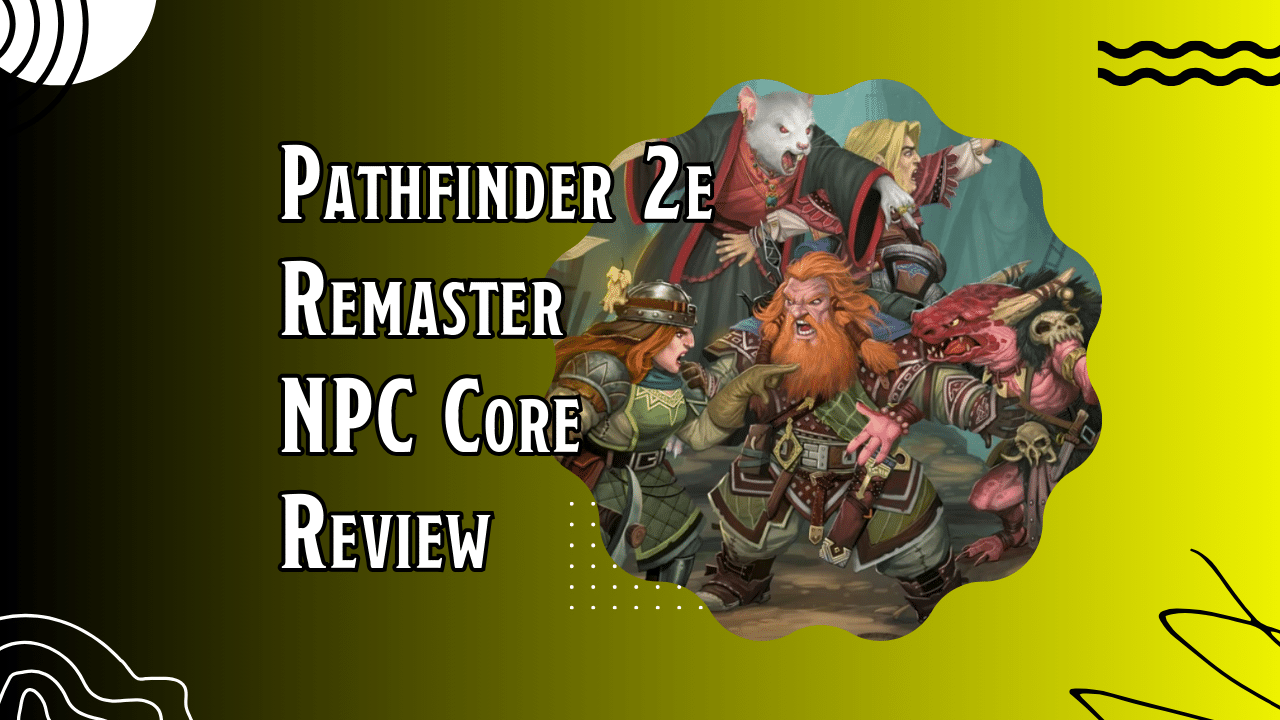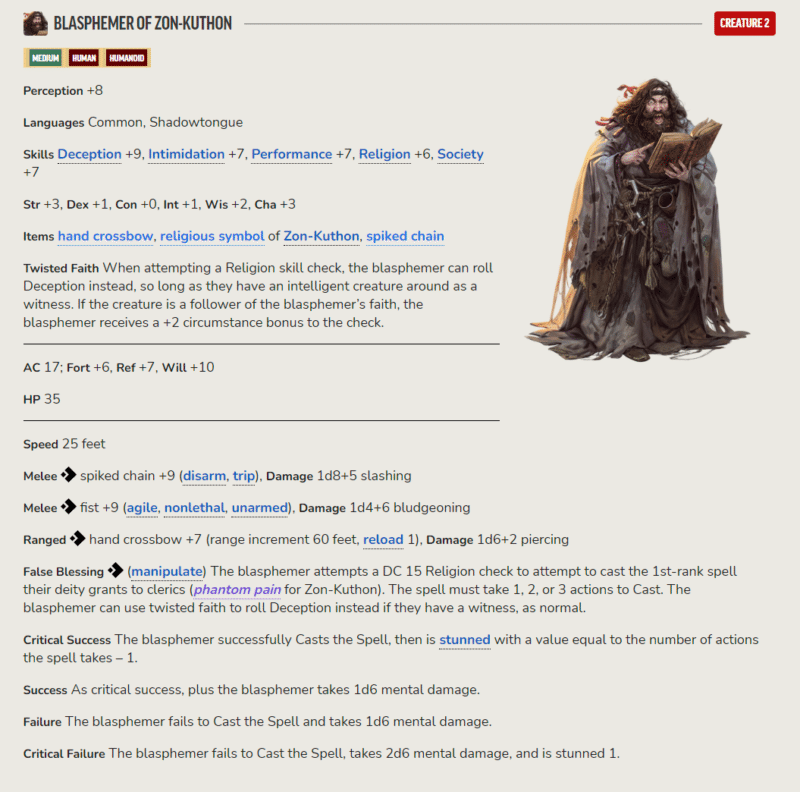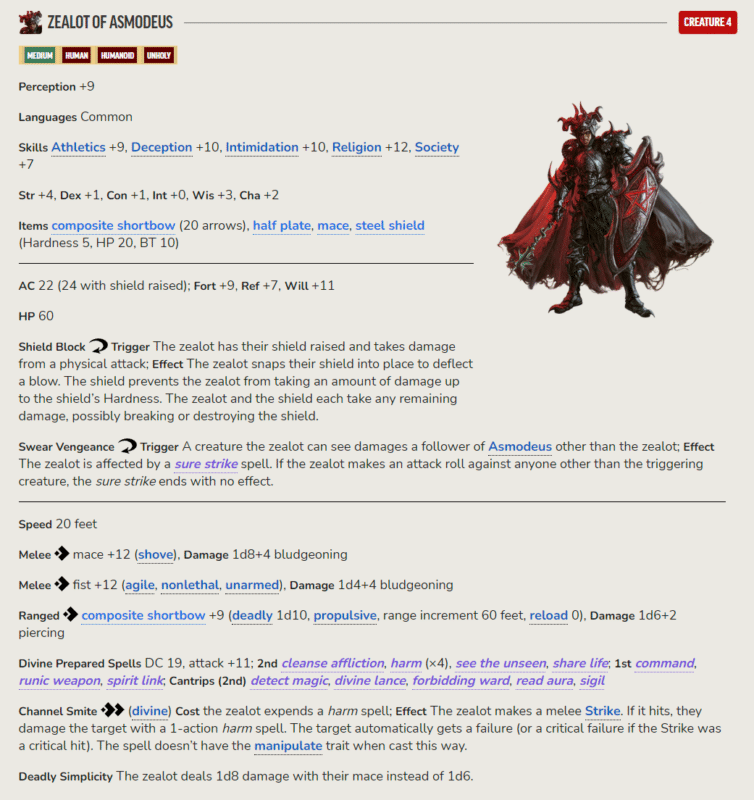What's that old saying, sometimes people are the real monsters? Something like that. Well, in Paizo's new NPC Core for Pathfinder Second Edition, that is certainly the case for me.
The Monster Core is great, but I tend to find myself pitting my parties against more human-like enemies, and the NPC Core is surprisingly versatile as a bestiary as well as a quick-and-easy way to populate your world.
I Didn't Know What to Expect
When the NPC Core was announced, I honestly didn't know what to expect. It certainly didn't sound like the kind of book I would be interested in. Initially, I had planned to pass it by. Even though it sounded cool, the overall description didn't seem like it was something that would get a lot of use in my games.
“You can drop all kinds of characters into your game, from merchants to farmers to masters of magic and martial arts. The NPCs are crafted to be fun and easy to use, with sets of adjustments to quickly change their ancestry, level, and more.”
One of my biggest strengths as a game master is pulling random things out of the air. I love random tables and all, but most of the time, I just say the first thing that pops into my head, and that's what we go with. For the most part, that works.
So when I read that the NPC core was just a bunch of themed NPCs that I could slot in when needed, I figured it was a cool idea to read and get ideas from, but that I'd never use it at my table.
I was wrong, and I am quite happy to admit it.
The NPC Core is So Much More Than Random Tables
I know better than to expect Paizo to put something out that's just a bunch of random tables, but for some reason, I couldn't wrap my head around this book being anything except that.
From the moment I read it was coming out, I figured it was just a lot of mix-and-match NPCs to go along with a handful of fleshed-out people.
I was wrong. I'm glad I was wrong.

As you can see in the image above, the NPC Core breaks up the NPCs by type, such as criminal, devotee, performer, scholar, villain, and so on. Inside those sections, numerous NPCs span the entire level range.
The Ancestry NPCs are broken up in the same way, but represent much more specific kinds of folks you might find in a kobold hovel or a gnome enclave.
The downside to all of these is that, for the most part, they aren't unique people. You get a goblin chef and details on how it reacts. But you don't get a dossier on Jim-Bob Bugglebutt the goblin chef.

These entries are archetypes for a particular kind of person. The NPC Core has a lot of detail in how this kind of person would react, but they don't have a full character portrait of any individual who could slot into the world.
That's a nitpick, admittedly, because every section, including the ancestries, has lore, new player and NPC options and items, spells, curses, random tables for this and that (but not all random tables!), and a lot of cool stuff I never expected.
Made for Pathfinder, Strong Enough for Starfinder
Tonight, as I draft this, I am going to be GMing a Starfinder game. We're playing second edition, and the adventure I'm running was released for 1e. That means I have a lot of converting to do with monsters and DCs and such.
Finding just the right monster to fit Aucturn Asunder isn't exactly easy. The Monster Core is great, but I only found decent-enough replacements. For the first session of the adventure, I ended up adjusting and homebrewing them myself with the help of some folks on Reddit.
When I got the NPC Core in the mail, I immediately went to the Devotee section to see if it had what I needed for the upcoming session. Lo and behold, there were perfect NPCs to fill up the final encounter.
Specifically, the Blasphemer of Zon-Kuthon and the Zealot of Asmodeus. You can click either of the images below to see the stat block in better detail.
Now, the only thing I really have to alter is to replace either Zon-Kuthon or Asmodeus with Nyarlathotep because that's who they're trying to revive in the adventure. Even the Cleric ability for the Blasphemer will work fine since Nyarlathotep isn't in the 2e rulebooks with a cleric gift.
I really like how easy it was to slot these in, and I am one-hundred percent certain that I'll be doing it with any other modules I run that are from SF1e (or PF1e, honestly, too).
Not Just NPCs, Either
As I said above, there's more than just NPCs in here. There are spells and lore, random tables and items. There are also game rules like the relationships & advancement system and the most wonderful part of it for me: the ability glossary.

There are a ton of terms in Pathfinder 2e, and it's hard to keep track of everything. Any book that adds a full glossary that ties to the book itself as a reference is a top-tier piece of work to me. (My favorite part of the D&D 2024 Player's Handbook was the rules glossary, too, btw.)
But this book doesn't stop there, no. Nope. There's more. There's another one!

That's right. The NPC Core has a second glossary that is mixed in with the index (which is standard for the PF2e books, and I love it) that clarifies rules and other terms not specific to this book itself.
On top of all that, there is lore and structure for organizations, themed spell lists for different kinds of NPCs, and as I mentioned before, a relationship system that is very similar to the video game ones we're used to in BioWare games, for instance.
PF2E NPC Core is Too Good to Pass Up
My favorite series of enemy book, bestiary, monster manual, or whatever you want to call it, has been the Kobold Press Tome of Beasts line since the moment I cracked the cover of the first one.
The PF2e NPC Core is right there with it, where I am going to be carrying it in my bag, regardless of which -finder game I'm playing, just like I keep one of the Tomes of Beasts in my bag when I'm playing 5e.
Geek to Geek Rating: 5 out of 5 NPC Stat Blocks
For more Starfinder and Pathfinder posts, check out my review of the Starfinder 2e Galaxy Guide and how I handled catch-up XP in my Pathfinder game.
TIP JAR: Help Geek to Geek Go Ad Free!
We hate ads. You hate ads. But they keep the site online. If you like our content, consider helping us out so we can remove annoying banners and pop-ups .




[…] Pathfinder Second Edition’s first rare class, a Charisma-based divine warrior possessing their own spark of divinity. Using […]
[…] I play Pathfinder on Thursday nights and Starfinder on Tuesday, and I find myself saying that I'm “going to […]
[…] I write this, I'm in the middle of a Pathfinder campaign and a Starfinder one. But I showed my players the Songs of the Spellbound Sea PDF Ben […]
[…] ton of creatures freely available from adventures and scenarios at this point, and if you have the PF2e NPC Core, they don't need much adaptation in many […]
[…] adventures themselves, as well as the playtest modules. (I've also stolen some straight out of the PF2e NPC Core. […]